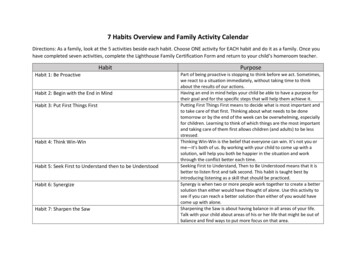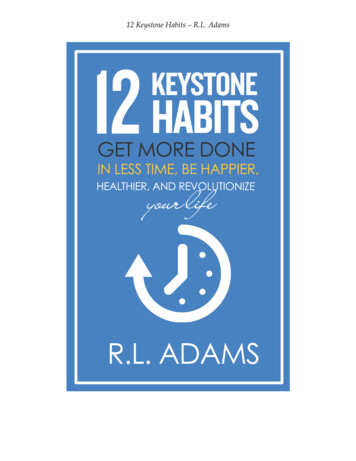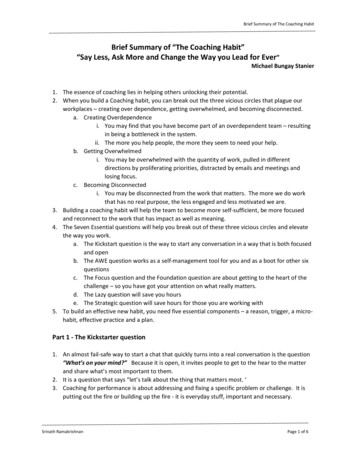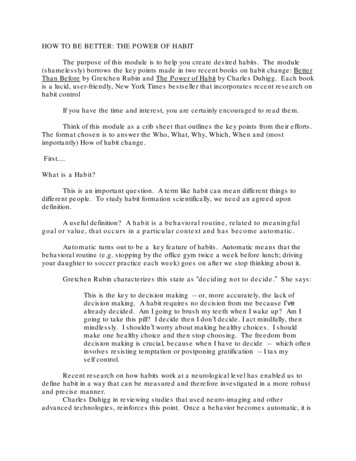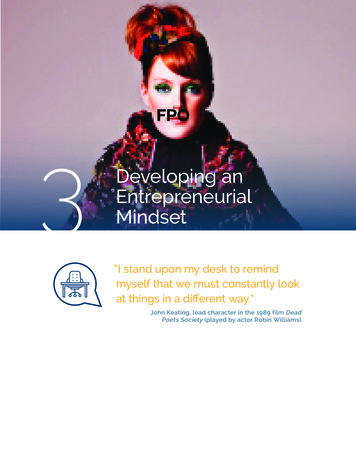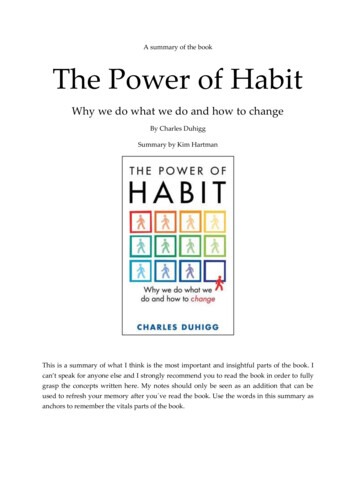
Transcription
A summary of the bookThe Power of HabitWhy we do what we do and how to changeBy Charles DuhiggSummary by Kim HartmanThis is a summary of what I think is the most important and insightful parts of the book. Ican’t speak for anyone else and I strongly recommend you to read the book in order to fullygrasp the concepts written here. My notes should only be seen as an addition that can beused to refresh your memory after you ve read the book. Use the words in this summary asanchors to remember the vitals parts of the book.
ContentsDescription from amazon . 2Prologue . 3Part one – The habits of individuals . 4Chapter 1: The habit loop – how habits work . 4Chapter 2: The craving brain – how to create new habits . 5Chapter 3: The golden rule of habit change – why transformation occurs . 6Part two – The habits of successful organizations . 8Chapter 4: Keystone Habits – which habits matter most . 8Chapter 5: The habit of success – when willpower becomes automatic. . 9Chapter 6: The power of crisis – creating habits through accident and design . 10Chapter 7: When companies predict and manipulate habits . 11Part three – The habits of societies . 12Chapter 8: How movements happen . 12Chapter 9: The neurology of free will – are we responsible for our habits? . 14Appendix . 15Previous book summaries . 16The End . 17More book summaries at www.kimhartman.seContact me at Kim.hartman@hyperisland.se
Description from amazonIn The Power of Habit, award-winning New York Times business reporter Charles Duhiggtakes us to the thrilling edge of scientific discoveries that explain why habits exist and howthey can be changed. With penetrating intelligence and an ability to distill vast amounts ofinformation into engrossing narratives, Duhigg brings to life a whole new understanding ofhuman nature and its potential for transformation.Along the way we learn why some people and companies struggle to change, despite yearsof trying, while others seem to remake themselves overnight. We visit laboratories whereneuroscientists explore how habits work and where, exactly, they reside in our brains. Wediscover how the right habits were crucial to the success of Olympic swimmer MichaelPhelps, Starbucks CEO Howard Schultz, and civil-rights hero Martin Luther King, Jr. We goinside Procter & Gamble, Target superstores, Rick Warren's Saddleback Church, NFL lockerrooms, and the nation's largest hospitals and see how implementing so-called keystonehabits can earn billions and mean the difference between failure and success, life and death.At its core, The Power of Habit contains an exhilarating argument: The key to exercisingregularly, losing weight, raising exceptional children, becoming more productive, buildingrevolutionary companies and social movements, and achieving success is understandinghow habits work.Habits aren't destiny. As Charles Duhigg shows, by harnessing this new science, we cantransform our businesses, our communities, and our lives.More book summaries at www.kimhartman.seContact me at Kim.hartman@hyperisland.se
PrologueKeystone habit: focus on one pattern – a keystone habit - and reprogram the other routinesin your life as well.40% of the actions people perform each day aren’t actual decisions but habits.The riot in Iraq example: Violence was usually preceded by a crowd of Iraqis gathering in aplaza or an open space, and over the course of several hours, growing in size. Food vendorswould show up, as well as spectators. Then someone would throw a rock and hell brokeloose. The police prohibited the food vendors from entering the plaza and people gathered asusual. The crowd grew in size, but at dusk people started to get hungry and there were nokebab to be found nearby. The chanters became dispirited, and at 8pm everyone was gone.More book summaries at www.kimhartman.seContact me at Kim.hartman@hyperisland.se
Part one – The habits of individualsChapter 1: The habit loop – how habits workHabits emerge because the brain is constantly looking for ways to save effort.The habit loop: The process with our brain is a three-step loop. First, there is a cue, a triggerthat tells your brain to go into automatic mode and which habit to use. Then there is theroutine, which can be physical or mental or emotional. Finally, there is a reward, which helpsyour brain figure out if this particular loop is worth remembering for the future. Cue –routine – rewardOver time, this loop becomes more and more automatic. The cue and reward becomeintertwined until a powerful sense of anticipation and craving emerges. Eventually, a habit isborn.When a habit emerges, the brain stops fully participating in decision making. It stopsworking so hard, or diverts focus to other tasks. So unless you deliberately fight a habit –unless you find new routines – the pattern will unfold automatically.Habits never really disappear. They are encoded into the structures of our brain.If we learn to create new neurological routines that overpower those behaviors – if we takecontrol of the habit loop – we can force those bad tendencies into the background. And oncesomeone creates a new pattern, studies have demonstrated, going for a jog or ignoring thedoughnuts becomes as automatic as any other habit.Habits, as much as memory and reason, are at the root of how we behave. We might notremember the experiences that create our habits, but once they are lodged within our brainsthe influence how we act – often without our realization.Example: McDonalds and kids. When the kids are starving and you are driving home aftera long day it makes sense to stop by McDonalds – it’s inexpensive and taste good. One mealof processed food can’t be that bad, right? But habits emerge without our permission. Studiesindicate that families usually don’t intend to eat fast food on a regular basis. What happens isthat a once in a month pattern slowly becomes once in a week, and then twice a week.As the cues and rewards creates a habit – until the kids are consuming an unhealthy amountof hamburgers and fries. There are a number of cues and rewards that most customers neverknew were influencing their behavior – every McDonalds looks the same, the employeessays the same things, so everything is a consistent cue to trigger eating routines.More book summaries at www.kimhartman.seContact me at Kim.hartman@hyperisland.se
The fries are designed to begin disintegrating the moment they hit your tongue, in order todeliver a hit of salt and grease as fast as possible, causing your pleasure centers to light upand your brain to lock in the pattern. Everything for the habit loop.Chapter 2: The craving brain – how to create new habitsCraving is what makes cues and rewards work. The craving is what powers the habit loop.1. Find a simple and obvious cue2. Clearly define the rewardsHabits create neurological cravings. As we associate cues with certain rewards, asubconscious craving emerges in our brain that starts the habit loop spinning.How to create a new habit: put together a cue, a routine and a reward, and then cultivate acraving that drives the loop.A cue and a reward on their own aren’t enough for a new habit to last. Only when your brainstarts expecting the reward – craving the endorphins or sense of accomplishment – will itbecome automatic to lace up your jogging shoes each morning. The cue, in addition totriggering a routine, must also trigger a craving for the reward to come.Toothpaste example: Claude Hopkins wasn’t selling beautiful teeth. He was selling asensation. Once people craved that cool tingeling – once they equated it with cleanliness –brushing became a habit. While everyone brushes their teeth, fewer than 10% of Americansapply sunscreen every day. Why? Because there is no craving that has made sunscreen into adaily habit.Craving is what drives habits. And figuring out how to spark a caving makes creating a newhabit easier.More book summaries at www.kimhartman.seContact me at Kim.hartman@hyperisland.se
Chapter 3: The golden rule of habit change – why transformation occursYou can never truly extinguish bad habits. Rather, to change a habit, you must keep the oldcue, and deliver the old reward, but insert a new routine. That’s the rule; if you use the samecue, and provide the same reward, you can shift the routine and change the habit. Almostany behavior can be transformed if the cue and reward stay the same.Anonymous alcoholicsAA succeeds because it helps alcoholics use the same cues, and get the same reward, but itshift the routine. The program forces people to identify the cues and rewards that encouragetheir alcoholic habits, and then helps them find new behaviors. To change an old habit youmust address an old craving. You have to keep the same cues and rewards as before, andfeed the craving by inserting a new routine.Often, intoxication itself doesn’t make the list. Alcoholics crave a drink because it offersescape, relaxation, companionship, the blunting of anxieties, and an opportunity foremotional release. They might crave a cocktail to forget their worries. But they don’tnecessarily crave a cocktail to forget their worries. The physical effects of alcohol are oftenone of the least rewarding parts of drinking to addicts.AA forces you to create new routines for what to do each night instead of drinking. AA: smethods have been refined into therapies that can be used to disrupt almost any pattern.Often, we don’t really understand the craving driving our behaviors until we look for them.AA believing example: Those alcoholics that believed that some higher power had enteredtheir lives were more likely to make it through the stressful periods with their sobriety intact.It wasn’t god that mattered, it was the belief itself that made a difference. Once peoplelearned how to believe in something, that skill started spilling over to other parts of theirlives, until they started believing they could change. Belief was the ingredient that made areworked habit loop into a permanent behavior.Even if you give people better habits, it doesn’t repair why they started drinking in the firstplace. Eventually they ll have a bad day, and no new routine is going to make everythingseem ok. What can make a difference is believing that they can cope with that stress withoutalcohol.AA trains in how to believe in something until they believe in the program and themselves.“If it worked for that guy, I guess it can work for me”. There is something powerful aboutgroups and shared experiences. People might be skeptical about their ability to change ifthey re by themselves, but a group will convince them to suspend disbelief. A communitycreates belief.More book summaries at www.kimhartman.seContact me at Kim.hartman@hyperisland.se
Change occurs among other people. When people join groups where change seems possible,the potential for that change to occur becomes more real. Belief is easier when it occurswithin a community.If we keep the same cue and the same reward, a new routine can be inserted. But that’s notenough. For a habit to stay changed, people must believe change is possible. And most often,that belief only emerges with the help of a group.Chapter conclusions: If you want to change a habit, you must find an alternative route, andyour odds for success go up dramatically when you commit to changing as part of a group.Belief is essential, and it grows out of a communal experience, even if that community is onlyas large as two people.More book summaries at www.kimhartman.seContact me at Kim.hartman@hyperisland.se
Part two – The habits of successful organizationsChapter 4: Keystone Habits – which habits matter mostKeystone Habits: Some habits have the power to start a chain reaction, changing other habitsas they move through an organization. Some habits, in other words, matter more than othersin remaking businesses and lives. These are Keystone Habits, and they can influence howpeople work, eat, play, live, spend, and communicate. Keystone habits start a process that,over time, transforms everything.Keystone habits say that success doesn’t depend on getting every single thing right, butinstead relies on identifying a few key priorities and fashioning them into powerful levels.The habits that matter the most are the ones that, when they start to shift, dislodge andremake other patterns.Families who habitually eat dinner together seem to raise children with better homeworkskills, higher grades, greater motional skills, and more confidence.Detecting keystone habits means searching out certain characteristics. Keystone habits offerwhat is known within academic literature as “small wins”. They help other habits to flourishby creating new structures, and they establish cultures where change becomes contagious.Small wins are part of how keystone habits create widespread changes. Small wins are asteady application of a small advantage. Once a small win has been accomplished, forces areset in motion that favors another small win. Small wins fuel transformative changes byleveraging tiny advantages into patterns that convince people that bigger achievements arewithin reach.Small wins: Small wins do not combine in a neat, linear, serial form, with each step being ademonstrable step closer to some predetermined goal. More common is the circumstancewhere small wins are scattered like miniature experiments that test implicit theories aboutresistance and opportunity and uncover both resources and barriers that were invisiblebefore the situation was stirred up.Keystone habits encourage change by creating structures that help other habits to flourish.Keystone habits transform us by creating cultures that make clear the values that, in the heatof a difficult decision or a moment of uncertainty, we might otherwise forget.More book summaries at www.kimhartman.seContact me at Kim.hartman@hyperisland.se
Chapter 5: The habit of success – when willpower becomes automatic.Willpower is the single most important keystone habit for individual success.Willpower isn’t just a skill. It is a muscle and it gets tired as it works harder, so there is lesspower left over for other things.If you want to do something that requires willpower – like going for a run after work – youhave to conserve your willpower muscle during the day. If you use it up too early on tedioustasks like writing emails or filling out boring forms, all the strength will be gone by the timeyou get home.The willpower experiment: 29 people were signed up for a 4 months money managementprogram. The participants were to deny themselves luxury’s and asked to keep detailed logsof everything they bought. People finances improved as they progressed through theprogram, but there were also side effects. They smoked fewer cigarettes, drank less boozeand coffee, ate les junk food and were more productive at work. As people strengthenedtheir willpower muscles in one part of their lives, that strength spilled over into what theyate or how hard they worked. Once willpower became stronger, it touched everything.This is why signing up kids for piano lessons or sports are so important. It has nothing to dowith creating a good musician or a football star. When you learn to force yourself to practicefor an hour or run fifteen laps, you start building self-regulatory strength.How willpower becomes a habit: By choosing a certain behavior ahead of time, and thenfollowing that routine when an inflection point arrives.When people are asked to do something that takes self-control, if they think they are doing itfor personal reasons – if they feel like it s a choice or something they enjoy because it helpssomeone else – it’s much less taxing. If they feel like they have no autonomy, if they re justfollowing orders, their willpower muscles get tired much faster.More book summaries at www.kimhartman.seContact me at Kim.hartman@hyperisland.se
Chapter 6: The power of crisis – creating habits through accident and designIt may seem like most organizations make rational choices based on deliberate decisionmaking, but that’s not really how companies operate at all. Instead, firms are guided by longheld organizational habits, patterns that often emerge from thousands of employeesindependent decisions.Routines reduce uncertainty. Routines provide the hundreds of unwritten rules thatcompanies need to operate. They allow workers to experiment with new ideas withouthaving to ask for permission at every step. They provide a kind of organizational memory,so that managers don’t have to reinvent the sales process every six months or panic eachtime a VP quits. Routines reduce uncertainty.Among the most important benefits of routines is that they create truces between potentiallywarring groups or individuals within an organization.Companies aren’t families. They are battlefields in a civil war.Organizational habits offer a basic promise: if you follow the established patterns and abideby the truce, the rivalries won’t destroy the company, the profit will roll in, and, eventually,everyone will be rich.Truces are only durable when they create real justice. If a truce I unbalanced – if the peaceisn’t real – the routines often fail when they are needed the most.Creating successful organizations isn’t just a matter of balancing authority, for anorganization to work, leaders must cultivate habits that both create a real and balanced peaceand, paradoxically, make it absolutely clear who s in charge.A company with dysfunctional habits can’t turn around simply because a leader orders it.Rather, wise executives seek out moments of crisis – or create the perception of crisis – andcultivate the sense that something must change, until everyone is finally ready to overhandthe patterns they live with each day.More book summaries at www.kimhartman.seContact me at Kim.hartman@hyperisland.se
Chapter 7: When companies predict and manipulate habitsThe first things you see upon entering the grocery store are the fruits and vegetablesarranged in attractive, bountiful piles. If we start our shopping sprees by loading up onhealthy stuff, we re much more likely to buy Doritos or frozen pizza when we encounterthem later on.Peoples buying habits are more likely to change when they go through a major life event.When someone gets married, for example, they are more likely to start buying a new type ofcoffee.Sticky songs are what you expect to hear on radio. Your brain secretly wants that song,because it’s so familiar o everything else you’ve already heard and liked. It just sounds right.The areas in the brain that process music are designed to seek out patterns and look forfamiliarity. Our brains crave familiar music because familiarity is how we manage to hearwithout becoming distracted by all the sound. That’s why songs that sound familiar – even ifyou’ve never heard them before – are sticky. Our brains are designed to prefer auditorypatterns that seem similar to what we ve already heard. When Celine Dion releases a newsong and it sounds the same as her previous songs, our brains unconsciously crave itsrecognizability and the song becomes sticky.We react to the cues (this sounds like all the other songs I’ve ever liked) and rewards (its funto hum along) and without thinking, we either start singing, or reach over and changestation.If you dress a new something in old habits, it’s easier for the public to accept it.More book summaries at www.kimhartman.seContact me at Kim.hartman@hyperisland.se
Part three – The habits of societiesChapter 8: How movements happenSocial habits: the behaviors that occur, unthinkingly, across dozens or hundreds orthousands of people which are often hard to see as they emerge, but which contain powerthat can change the world. Social habits are what fill streets with protesters who may notknow one another, who might be marching for different reasons, but who are all moving inthe same direction. Social habits are why some initiatives become world changingmovements, while others fail to ignite.At the root of many movements is a 3 part process that historians and sociologists sayshow up again and again:1. A movement starts because of the social habits of friendship and the strong tiesbetween close acquaintances.2. It grows because of the habits of a community, and the weak ties that holdneighborhoods and clans together.3. And it endures because a movement’s leader gives participants new habits that createa fresh sense of identity and a feeling of ownership.Only when all three part of this process are fulfilled can a movement become self-propellingand reach a critical mass.Our deepest relationships tend to be with people who look like us, earn about the sameamount of money, and come from a similar background.There s a natural instinct embedded in friendship, a sympathy that makes us willing to fightfor someone we like when they are treated unjustly. Studies show that people have noproblem ignoring stranger’s injuries, but when a friend is insulted, our sense of outrage isenough to overcome the inertia that usually makes protests hard to organize.The power of weak ties: represents the links that connect people who have acquaintances incommon, who share membership in social networks, but aren’t directly connected by thestrong ties of friendship themselves. Weak-tie acquaintances are often more important thanstrong-tie friends because weak ties give us access to social networks where we don’totherwise belong.The habits of peer pressure: the social habits that encourage people to conform to groupexpectations. The habits of peer pressure often spread through weak ties, and they gain theirauthority through communal expectations.When the strong ties of friendship and the weak ties of peer pressure merge, widespreadsocial change can begin.More book summaries at www.kimhartman.seContact me at Kim.hartman@hyperisland.se
For an idea to grow beyond a community, it must become self-propelling. And the surestway to achieve that is to give people new habits that help the figure out where to go on theirown.Movements don’t emerge because everyone suddenly decides to face the same direction atonce. They rely on social patterns that begin as the habit of friendship, grow through thehabits of communities, and are sustained by new habits that change participant’s sense ofself.More book summaries at www.kimhartman.seContact me at Kim.hartman@hyperisland.se
Chapter 9: The neurology of free will – are we responsible for our habits?The Switch: As our bodies move in and out of different phases of rest, our most primitiveneurological structure – the brain stem – paralyzes our limbs and nervous system, allowingour brains to experience dreams without our bodies moving.To pathological gamblers, near misses looked like wins. Their brains reacted almost the sameway. But to a non-pathological gambler, a near miss was like a loss. Real neurologicaldifferences impact how pathological gamblers process information. Adding a near miss to alottery is like pouring jet fuel on a fire. And every scratch off ticket is designed to make youfeel like you almost won.Once you understand that habits can change, you have the freedom – and the responsibility– to remake them. If you believe you can change – if you make it a habit – the changebecomes real. This is the real power of habit: the insight that your habit is what you choosethem to be. Once that choice occurs – and becomes automatic – it s not only real, it starts toseem inevitable.More book summaries at www.kimhartman.seContact me at Kim.hartman@hyperisland.se
AppendixThe framework:1. Identify the routine2. Experiment with rewards3. Isolate the cue4. Have a planRewards are powerful because they satisfy cravings. But we re often not conscious of thecravings that drive our behaviors.Test different hypotheses: What you choose to do instead of buying a cookie isn’timportant. The point is to test different hypotheses to determine which craving is drivingyour routine. As you test 4 or 5 different rewards, you can use an old trick to look forpatterns: after each activity, jot down on a piece of paper the first three things that come tomind when you get back to your desk. They can be emotions, random thoughts, reflectionson how you re feeling, or just the first three words that pop up into your head.By experimenting with different rewards, you can isolate what you are actually craving,which is essential in redesigning the habit.The reason why it is so hard to identify the cues that trigger our habits is because there is toomuch information bombarding us as our behaviors unfold.Experiments have shown that almost all habitual cues fit into one of five categories: Location Time Emotional state Other people Immediately preceding actionOnce you ve figured out your habit loop – you have identified the reward driving yourbehavior, the cue triggering it, and the routine itself – you can begin to shift the behavior.You can change to a better routine by planning for the cue and choosing a behavior thatdelivers the reward you are craving. What you need is a plan.A habit is a formula our brain automatically follows: when I see CUE, I will do ROUTINEin order to get REWARD.More book summaries at www.kimhartman.seContact me at Kim.hartman@hyperisland.se
Previous book summariesEating the Big Fish by Adam MorganStorytelling – Branding in practice by Klaus FogThe Switch – How to change things when change is hard by Chip & Dan HeathA Whole New Mind: Why Right-Brainers Will Rule the FutureThe Element – How finding your passion changes everything by Ken RobinsonDisciplined Dreaming: A Proven System to Drive Breakthrough Creativity by Josh LinknerBounce – The myth of talent and the power of practice by Matthew SyedThe Two-Second Advantage by Vivek Ranadive and Kevin ManeyThe Idea Writers by Teressa IezziVelocity – The seven new laws of a world gone digitalStart With Why by Simon SinekMore book summaries at www.kimhartman.seContact me at Kim.hartman@hyperisland.se
The EndThat s all Folks!More book summaries at www.kimhartman.seContact me at Kim.hartman@hyperisland.se
A summary of the book The Power of Habit Why we do what we do and how to change By Charles Duhigg Summary by Kim Hartman This is a summary of what I think is the most important and insightful parts of the book. I can't speak for anyone else and I strongly recommend you to read the book in order to fully grasp the concepts written here.




